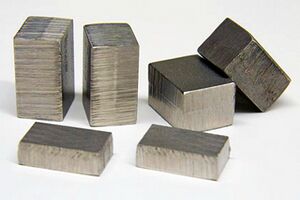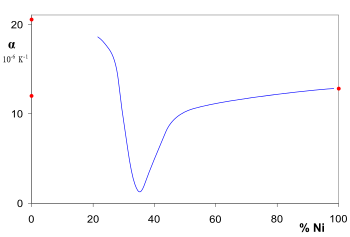إنڤار
إنڤار Invar، ويُعرف عموماً أيضاً بإسم FeNi36 (64FeNi في الولايات المتحدة)، هي سبيكة نيكل–حديد تـُذكـَر بقدرتها الفريدة على معامل التمدد الحراري (CTE أو α) المنخفض. الاسم إنڤار Invar يأتي من الكلمة invariable أي غير قابل للتغير، وهي إشارة إلى فقدانها النسبي للتمدد أو الإنكماش بتغير درجة الحرارة،[1] والاسم هو علامة تجارية مسجلة لشركة أرسلورميتال.[2]
The discovery of the alloy was made in 1895 by Swiss physicist Charles Édouard Guillaume for which he received the Nobel Prize in Physics in 1920. It enabled improvements in scientific instruments.[3]
الخصائص
Like other nickel/iron compositions, Invar is a solid solution; that is, it is a single-phase alloy. In one commercial version it consists of approximately 36% nickel and 64% iron.[4] The invar range was described by Westinghouse scientists in 1961 as "30–45 atom per cent nickel".[5]
Common grades of Invar have a coefficient of thermal expansion (denoted α, and measured between 20 °C and 100 °C) of about 1.2 × 10−6 K−1 (1.2 ppm/°C), while ordinary steels have values of around 11–15 ppm/°C.[بحاجة لمصدر] Extra-pure grades (<0.1% Co) can readily produce values as low as 0.62–0.65 ppm/°C.[بحاجة لمصدر] Some formulations display negative thermal expansion (NTE) characteristics.[بحاجة لمصدر] Though it displays high dimensional stability over a range of temperatures, it does have a propensity to creep.[6][7]
التطبيقات
Invar is used where high dimensional stability is required, such as precision instruments, clocks, seismic creep gauges, television shadow-mask frames,[8] valves in engines and large aerostructure molds.[9]
One of its first applications was in watch balance wheels and pendulum rods for precision regulator clocks. At the time it was invented, the pendulum clock was the world's most precise timekeeper, and the limit to timekeeping accuracy was due to thermal variations in length of clock pendulums. The Riefler regulator clock developed in 1898 by Clemens Riefler, the first clock to use an Invar pendulum, had an accuracy of 10 milliseconds per day, and served as the primary time standard in naval observatories and for national time services until the 1930s.
In land surveying, when first-order (high-precision) elevation leveling is to be performed, the level staff (leveling rod) used is made of Invar, instead of wood, fiberglass, or other metals.[10][11] Invar struts were used in some pistons to limit their thermal expansion inside their cylinders.[12] In the manufacture of large composite material structures for aerospace carbon fibre layup molds, Invar is used to facilitate the manufacture of parts to extremely tight tolerances.[13]
In the astronomical field, Invar is used as the structural components that support dimension-sensitive optics of astronomical telescopes.[14] Superior dimensional stability of Invar allows the astronomical telescopes to significantly improve the observation precision and accuracy.
تنويعات
There are variations of the original Invar material that have slightly different coefficient of thermal expansion such as:
- Inovco, which is Fe–33Ni–4.5Co and has an α of 0.55 ppm/°C (from 20 to 100 °C).[بحاجة لمصدر][بحاجة لأمثلة]
- FeNi42 (for example NILO alloy 42), which has a nickel content of 42% and α ≈ 5.3 ppm/°C, matching that of silicon, is widely used as lead frame material for integrated circuits, etc.[بحاجة لمصدر]
- FeNiCo alloys—named Kovar or Dilver P—that have the same expansion behaviour (~5 ppm/°C) and form strong bonds with molten borosilicate glass, and because of that are used for glass-to-metal seals, and to support optical parts in a wide range of temperatures and applications, such as satellites.[بحاجة لمصدر]
شرح الخصائص الشاذة
A detailed explanation of Invar's anomalously low CTE has proven elusive for physicists.
All the iron-rich face-centered cubic Fe–Ni alloys show Invar anomalies in their measured thermal and magnetic properties that evolve continuously in intensity with varying alloy composition. Scientists had once proposed that Invar's behavior was a direct consequence of a high-magnetic-moment to low-magnetic-moment transition occurring in the face centered cubic Fe–Ni series (and that gives rise to the mineral antitaenite); however, this theory was proven incorrect.[15] Instead, it appears that the low-moment/high-moment transition is preceded by a high-magnetic-moment frustrated ferromagnetic state in which the Fe–Fe magnetic exchange bonds have a large magneto-volume effect of the right sign and magnitude to create the observed thermal expansion anomaly.[16]
Wang et al. considered the statistical mixture between the fully ferromagnetic (FM) configuration and the spin-flipping configurations (SFCs) in Fe 3Pt with the free energies of FM and SFCs predicted from first-principles calculations and were able to predict the temperature ranges of negative thermal expansion under various pressures.[17] It was shown that all individual FM and SFCs have positive thermal expansion, and the negative thermal expansion originates from the increasing populations of SFCs with smaller volumes than that of FM.[18]
انظر أيضاً
- Constantan and Manganin, alloys with relatively constant electrical resistivity
- Elinvar, alloy with relatively constant elasticity over a range of temperatures
- Sitall and Zerodur, ceramic materials with a relatively low thermal expansion
- Borosilicate glass and Ultra low expansion glass, low expansion glasses resistant to thermal shock
المراجع
- ^ Davis, Joseph R. (2001). Alloying: Understanding the Basics. ASM International. pp. 587–589. ISBN 0-87170-744-6.
- ^ US Trademark #63970
- ^ "The Nobel Prize in Physics 1920". nobelprize.org. The Nobel Foundation. Retrieved 20 March 2011.
The Nobel Prize in Physics 1920 was awarded to Charles Edouard Guillaume "in recognition of the service he has rendered to precision measurements in Physics by his discovery of anomalies in nickel steel alloys".
- ^ "Material Data Sheet Alloy 36" (PDF). Retrieved 24 November 2017.
- ^ Ananthanarayanan, N. I.; Peavler, R. J. (1961). "A New Reversible Solid-State Transformation in Iron–Nickel Alloys in the Invar Range of Compositions". Nature. 192 (4806): 962–963. Bibcode:1961Natur.192..962A. doi:10.1038/192962a0. S2CID 4277440.
- ^ Myslowicki, Thomas; Crumbach, Mischa; Mattissen, Dorothea; Bleck, Wolfgang (August 2002). "Short time creep behaviour of Invar steel". Steel Research (in الإنجليزية). 73 (8): 332–339. doi:10.1002/srin.200200218.
- ^ Thackar, Romin A.; Trivedi, Snehal V. (June 2017). "An Overview of Dimensional Stability of Invar 36 Material for Space Based Optical Mounting Applications" (PDF). International Conference on Ideas, Impact and Innovation in Mechanical Engineering (ICIIIME 2017). 5 (6): 147.
- ^ "Nickel & Its Uses". Nickel Magazine. Nickel Institute. 3 May 2005. Archived from the original on 19 December 2010. Retrieved 20 March 2011.
- ^ (in en)Boeing 787 Fuselage (MIE-375), https://www.youtube.com/watch?v=VyWFiUnoT5E, retrieved on 2023-06-29
- ^ Baričević, Sergej; Barković, Đuro; Zrinjski, Mladen; Staroveški, Tomislav (2022). Ademović, Naida; Mujčić, Edin; Akšamija, Zlatan; Kevrić, Jasmin; Avdaković, Samir; Volić, Ismar (eds.). "Development of Levelling Staff Scale Calibration Method by Integrating a CCD Camera". Advanced Technologies, Systems, and Applications VI. Lecture Notes in Networks and Systems (in الإنجليزية). Cham: Springer International Publishing: 514–521. doi:10.1007/978-3-030-90055-7_40. ISBN 978-3-030-90055-7.
- ^ "ISO 12858-1:2014 Optics and optical instruments — Ancillary devices for geodetic instruments — Part 1: Invar levelling staffs". ISO (in الإنجليزية). Retrieved 2023-09-02.
- ^ Internal combustion engines illustrated. Long Acre, London: Odhams Press Limited. 1947. p. 85.
- ^ Tooling to mould and die for! Archived 10 أبريل 2018 at the Wayback Machine, Mike Richardson, Aerospace Manufacturing, 6 April 2018, accessed 10 April 2018.
- ^ Fujii, Hiromichi T.; Sakaguchi, Naoki; Ona, Kotaro; Hayano, Yutaka; Uraguchi, Fumihiro (2020). "Precise control of negative thermal expansion in stainless invar type alloy for astronomical telescopes". In Geyl, Roland; Navarro, Ramón (eds.). Advances in Optical and Mechanical Technologies for Telescopes and Instrumentation IV. Vol. 11451. p. 1145118. Bibcode:2020SPIE11451E..18F. doi:10.1117/12.2561193. ISBN 9781510636897. S2CID 230575165. Retrieved 2021-05-08.
- ^ K. Lagarec; D.G. Rancourt; S.K. Bose; B. Sanyal; R.A. Dunlap (2001). "Observation of a composition-controlled high-moment/low-moment transition in the face centered cubic Fe–Ni system: Invar effect is an expansion, not a contraction" (PDF). Journal of Magnetism and Magnetic Materials. 236 (1–2): 107–130. Bibcode:2001JMMM..236..107L. doi:10.1016/S0304-8853(01)00449-8. Archived from the original (PDF) on 25 April 2012.
- ^ D.G. Rancourt; M.-Z. Dang (1996). "Relation between anomalous magneto-volume behaviour and magnetic frustration in Invar alloys". Physical Review B. 54 (17): 12225–12231. Bibcode:1996PhRvB..5412225R. doi:10.1103/PhysRevB.54.12225. PMID 9985084.
- ^ Wang, Y., Shang, S. L., Zhang, H., Chen, L.-Q., & Liu, Z.-K. (2010). Thermodynamic fluctuations in magnetic states: Fe 3 Pt as a prototype. Philosophical Magazine Letters, 90(12), 851–859. https://doi.org/10.1080/09500839.2010.508446
- ^ Liu, Zi-Kui; Wang, Yi; Shang, Shunli (2014). "Thermal Expansion Anomaly Regulated by Entropy". Scientific Reports. 4: 7043. Bibcode:2014NatSR...4E7043L. doi:10.1038/srep07043. PMC 4229665. PMID 25391631.

